Introduction
Within This Page
- Introduction
- Description
- Application
- Operation and Maintenance
- Relevant Codes and Standards
- Additional Resources
THIS PAGE SUPPORTED BY THE
Passive solar heating is one of several design approaches collectively called passive solar design. When combined properly, these strategies can contribute to the heating, cooling, and daylighting of nearly any building. The types of buildings that benefit from the application of passive solar heating range from barracks to large maintenance facilities.
Typically, passive solar heating involves:
- The collection of solar energy through properly-oriented, south-facing windows.
- The storage of this energy in "thermal mass," comprised of building materials with high heat capacity such as concrete slabs, brick walls, or tile floors.
- The natural distribution of the stored solar energy back to the living space, when required, through the mechanisms of natural convection and radiation.
- Window specifications to allow higher solar heat gain coefficient in south glazing.
Passive solar heating systems do not have a high initial cost or long-term payback period, both of which are common with many active solar heating systems. Increased user comfort is another benefit to passive solar heating. If properly designed, passive solar buildings are bright and sunny and in tune with the nuances of climate and nature. As a result, there are fewer fluctuations in temperature, resulting in a higher degree of temperature stability and thermal comfort. By providing a delightful place to live and work, passive solar buildings can contribute to increased satisfaction and user productivity. In addition, passive solar design does not generate greenhouse gases and slows fossil fuel depletion.
There are a few considerations with passive solar design. First, to achieve the highest efficiency, the system needs to have maximum exposure to the sunlight. Second, the intensity of sunlight is intermittent, and the system can overload, which may adversely affect particular electrical appliances like air conditioners and computers. However, with the help of experienced passive solar designer architects and builders, passive solar design costs little more than conventional building design and saves money over the long term.
It is best to incorporate passive solar heating into a building during the initial design. The whole building approach evaluates it in the context of building envelope design (particularly for windows), daylighting, and heating and cooling systems. Passive solar heating strategies provide opportunities for daylighting and views to the outside through well-positioned windows. Window design—and especially glazing choices—is a critical factor for determining the effectiveness of passive solar heating. Passive solar features, such as additional south-facing windows, additional thermal mass, and roof overhangs, can easily pay for themselves. Overall, passive solar buildings are often less expensive when the lower annual energy and maintenance costs are factored in over the life of the building.
This overview is intended to provide specific details for Federal agencies considering passive solar heating technologies as part of a new construction project or major renovation.
Description
Passive solar heating systems make use of the building components to collect, store, and distribute solar heat gains to reduce the demand for space heating. A passive solar system does not require the use of mechanical equipment because the heat flow is by natural means, such as radiation, convection, and conductance, and the thermal storage is in the structure itself.
A passive solar heating system is made up of the following key components, all of which must work together for the design to be successful:
- Aperture (Collector)
- Absorber
- Thermal mass
- Distribution
- Control.
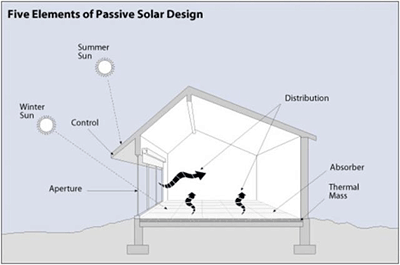
The five key elements of passive solar design.
In a passive solar heating system, the aperture (collector) is a large glass (window) area through which sunlight enters the building. Typically, the aperture(s) should face within 30° of true south and should not be shaded by other buildings or trees from 9 a.m. to 3 p.m. each day during the heating season.
The hard, darkened surface of the storage element is known as the absorber. This surface—which could consist of a masonry wall, floor, or partition (phase change material), or a water container—sits in the direct path of sunlight. Sunlight then hits the surface and is absorbed as heat.
The thermal mass is made up of materials that retain or store the heat produced by sunlight. The difference between the absorber and thermal mass, although they often form the same wall or floor, is that the absorber is an exposed surface, whereas thermal mass is the material below or behind that surface.
Distribution is the method by which solar heat circulates from the collection and storage points to different areas of the building. A strictly passive design will use the three natural heat transfer modes exclusively—conduction, convection, and radiation. In some applications, however, fans, ducts, and blowers may help with the distribution of heat through the building.
Elements to help control under- and overheating of a passive solar heating system include roof overhangs, which can be used to shade the aperture area during summer months, electronic sensing devices, such as a differential thermostat that signals a fan to turn on, operable vents and dampers that allow or restrict heat flow, low-emissivity blinds, and awnings.
How Does It Work?
Passive solar buildings are designed to let the heat into the building during the winter months, and block out the sun during hot summer days. This can be achieved by passive solar design elements such as shading, implementing large south-facing windows, and building materials that absorb and slowly release the sun's heat.
Passive Solar Design
Incorporating shading concepts into your landscape design can help reduce the solar heat gain in the summer and reduce cooling costs. The leaves of deciduous trees or bushes located to the south of the building can help block out sunshine and unneeded heat in the summer. These trees lose their leaves in the winter, and allow an increase in the solar heat gain during the colder days. Incorporating overhangs, awnings, shutters and trellises into the building design can also provide shade.
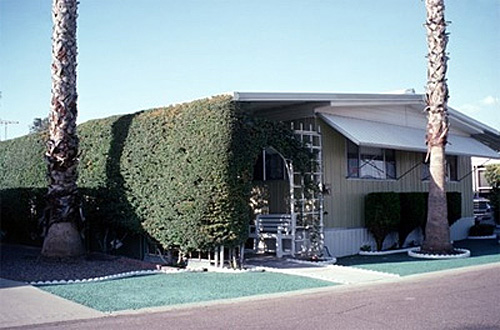
A trellis with a climbing vine can shade a home and allow air circulation.
Photo by John Krigger, Saturn Resource.
Effective thermal mass materials, like concrete, or stone floor slabs, have high specific heat capacities, as well as high density. It is ideally placed within the building where it is exposed to winter sunlight but insulated from heat loss. The material is warmed passively by the sun and releases the thermal energy into the interior during the night.
The most important characteristic of passive solar design is that it is holistic, and relies on the integration of a building's architecture, materials selection, and mechanical systems to reduce heating and cooling loads. It is also important to consider local climate conditions, such as temperature, solar radiation, and wind, when creating climate-responsive, energy conserving structures that can be powered with renewable energy sources.
In climates that are appropriate for passive solar heating, large south-facing windows are used, as they have the most sun exposure in all seasons. Although passive solar heating systems do not require mechanical equipment for operation, fans or blowers may be used to assist the natural flow of thermal energy. The passive systems assisted by mechanical devices are referred to as hybrid heating systems.
Passive solar systems utilize basic concepts incorporated into the architectural design of the building. This typically includes buildings with rectangular floor plans, elongated on an east-west axis, a glazed south-facing wall, a thermal storage media exposed to the solar radiation which penetrates the south-facing glazing, overhangs, or other shading devices, which sufficiently shade the south-facing glazing from the summer sun, and windows on the east and west walls, and preferably none on the north walls.
To achieve a high percentage of passive solar heating, it is necessary to incorporate adequate thermal mass in buildings. Specific guidelines for this include the following:
- Confirm that the area of thermal mass is six times the area of the accompanying glazing (when possible). For climates with foggy or rainy winters, somewhat less thermal mass is needed.
- Place the mass effectively by ensuring that it is directly heated by the sun or is spread in thin layers throughout rooms in which there is a large quantity of solar collection.
- Disregard the color of the mass surface. However, natural colors (e.g. colors in the 0.5 to 0.7 absorption range) are quite effective.
- Incorporate thermal storage in floors or walls that consist of concrete, masonry, or tile. To reflect light and enhance the space, walls should generally remain light colored.
Sizing of glass areas, insulation values, shading, and mass will depend on climate. Higher solar savings contributions will require greater amounts of glazing and mass. Be aware that the relationship between glass area and mass is not linear. For example, a doubling of glass area may require a tripling of effective thermal mass.
Skin-load and internal-load dominated
There are two main uses for passive solar heating: skin-load dominated buildings in cold and temperate climates, and internal-load dominated buildings in warm climates. For small, skin-load dominated buildings in cold and temperate climates, passive solar design often involves using solar energy to provide space heating. For other kinds of structures, such as internal-load dominated buildings in warm climates, responsible passive solar design is more likely to emphasize cooling avoidance using shading devices, high performance glazing, and daylighting.
In a skin-load dominated structure, energy consumption is primarily dictated by the influence of the exterior climate on a building's envelope, or "skin." Examples of typical skin-load dominated buildings include barracks and other low-rise housing, small warehouses, or small retail facilities.
Depending on climate, the passive solar design of skin-load dominated buildings might include:
- Orienting more windows to the south
- Shading to avoid summer sun
- Incorporating thermally massive construction materials
- Providing properly sized and installed insulation
- Downsizing heating, ventilating, and air conditioning (HVAC) equipment.
Internal-load dominated buildings such as educational facilities, offices, or large retail complexes often consume the majority of their energy to provide interior lighting and to provide cooling to counteract the heat given off by people, plug-loads (such as computers), fixtures, and other internal sources. Such buildings can require cooling year-round. Note, however, that less solar radiation enters a well-shaded south window in the summer than a similarly shaded window on the north, east, or west side of the building.
Depending on climate, the passive solar design of internal-load dominated buildings might include:
- Daylighting work spaces with properly oriented and controlled windows
- Specifying high-performance glazing that reduce heat gain while admitting visible light
- Selecting high-efficiency HVAC systems
- Incorporating adequate shading devices.
Types and Costs of Technology
There are four generic passive solar heating approaches for skin-load dominated buildings: (1) sun-tempered, (2) direct gain, (3) indirect gain, and (4) isolated gain.
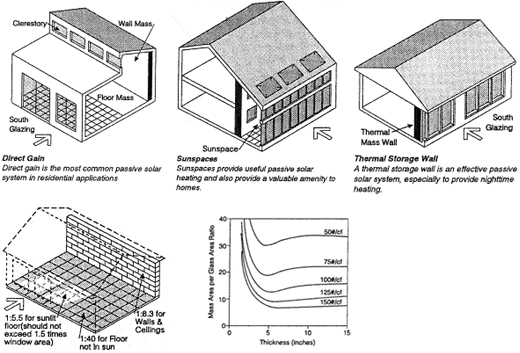
The four approaches for passive solar heating in skin-load dominated buildings
-
Sun-tempering is achieved through modest increases in south-facing windows. A tract builder's house typically has about one quarter of its windows on each facade with a south glass equal to about 3% of the house's total floor area. Depending on the climate, a sun-tempered house or barracks might increase this percentage to between 5% and 7%. In this case, no thermal mass needs to be added to the basic design (the "free mass" of gypsum wallboard and furnishings is sufficient to store the additional solar heat.)
-
Direct gain is the most basic form of passive solar heating. Sunlight admitted through south-facing glazing (in the Northern Hemisphere) enters the space to be heated, and is stored in a thermal mass incorporated into the floor or interior walls. Depending on climate, the total direct gain glass should not exceed about 12% of the house's floor area. Beyond that, problems with glare or fading of fabrics are likely to occur, and it becomes more difficult to provide enough thermal mass for year-round comfort.
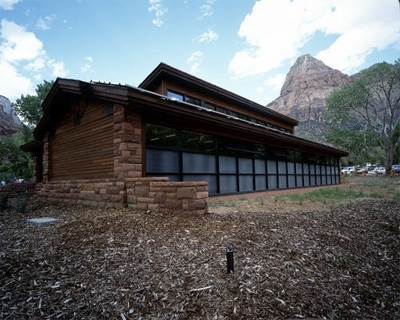
Zion's Visitor Center showing Trombe wall and clerestory windows.
-
An indirect gain passive solar heating system (also called a Trombe wall or a thermal storage wall) is a south-facing glazed wall, usually built of heavy masonry, but sometimes using containers of water or phase change materials. Sunlight is absorbed into the wall and it heats up slowly during the day. Then, as it cools gradually during the night, it releases its stored heat over a relatively long period of time indirectly into the space.
-
Isolated gain, or sunspace, passive heating collects the sunlight in an area that can be closed off from the rest of the building. The doors or windows between the sunspace and the building are opened during the day to circulate collected heat, and then closed at night, allowing the temperature in the sunspace to drop. Small circulating fans may also be used to move heat into adjacent rooms.
The Arizona Solar Center's Passive Solar Cooling and Heating Manual provides more information on passive solar design. Now available are exterior concrete walls that are insulated on the outside to protect the concrete from weather. To exchange heat with the room air, the concrete should be exposed on the inside.
Application
Passive solar heating strategies should only be used when appropriate. Passive solar heating works better in smaller buildings where the envelope design controls the energy demand. This means a space that is not already heated by busy people, lights, computers and other internal heat gain. Strategies, such as trombe walls, exist to mitigate unwanted glare and excessive heat gain, but care must be taken when introducing solar heat into workspaces. Passive solar heating is often used on circulation spaces such as lobbies and atria, hallways, break rooms, and other types of spaces with low internal heat gain that afford occupants the flexibility to move out of the sun.
The primary types of buildings that can benefit the most from the application of passive solar heating principles are:
- Barracks and other low-rise housing in temperate and cold climates (locations that experience above 2,000° days annually)
- Small Post Exchange (PX) facilities (less than 10,000 ft2)
- Warehouses
- Maintenance facilities.
Economics
Modest levels of passive solar heating, also called sun-tempering, can reduce building auxiliary heating requirements from 5% to 25% at little or no incremental first cost and should be implemented for all small buildings in temperate and cold climates. More aggressive passive solar heated buildings can reduce heating energy use by 25% to 75% compared to a typical structure while remaining cost-effective on a life-cycle basis. This approach should be considered for many small buildings in temperate and cold climates.
With the help of experienced passive solar designer architects and builders, passive solar design costs little more than conventional building design and saves money over the long term. However, in areas where experienced solar architects and builders are not available, construction costs can run higher than for conventional buildings, and mistakes can be made in the choice of building materials, especially window glass. For example, passive solar homes are often built using glass that rejects solar energy. Unfortunately, this is a costly mistake. The right glass choice depends on the climate and on which side of the building (east, west, north, or south) the glass is installed.
During the summer or in consistently warm climates, daylighting could actually increase energy use in a building by adding to its air-conditioning load.
Assessing Resource Availability
In climates with clear skies during the winter heating season and where alternative heating sources are relatively expensive, passive solar heating will tend to work the best and be the most economical option.
A good passive solar site is one that will allow its solar surfaces to face true south with a minimal amount of shading in the solar access zone. Facing solar surfaces to the south is not enough to ensure their performance; the area to the south must be clear of obstructions that could block the sun from reaching them. In the winter, there should be no significant blockage between 9 a.m. and 3 p.m. solar time.
Obstructions directly to the south of the building need to be located at a distance of at least 1.7 times their height away from the surface to avoid shading the building in winter. Obstructions located along the 45° lines east or west of south need to be at least 3.5 times their height away from the building to avoid shading. It is important to remember that the sun is lower in the sky and casts longer shadows in winter. Therefore, even if the site is unshaded in summer, it may not remain that way in winter.
Design Considerations
The following are general recommendations that should be followed in the application of passive solar heating technology.
- Pay careful attention when constructing a durable, energy-conserving building envelope.
- Address orientation issues during site planning. To the maximum extent possible, reduce glass on the east and west sides and protect openings from prevailing winter winds.
- Establish an air-tight seal around windows, doors, and electrical outlets on exterior walls. Employ entry vestibules and keep any ductwork within the insulated envelope of the building to ensure thermal integrity. Consider requiring blower-door tests of model homes to demonstrate air-tightness and minimize duct losses.
- Specify windows and glazing that have low thermal transmittance values (U values) while admitting adequate levels of incoming solar radiation (higher solar heat gain coefficient [SHGC]). Data sources such as the National Fenestration Rating Council's Certified Products Directory should be consulted for tested performance values. The amount of glazing will depend on building type and climate.
- Ensure that the south glass in a passive solar building does not contribute to increased summer cooling. In many areas, shading in summer is just as critical as admitting solar gain in winter. From the overhang figure below, use summer (B) and winter (A) sun angles to calculate optimum overhang design.
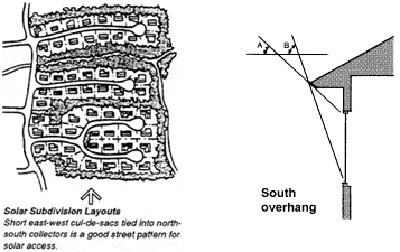
Solar Subdivision Layouts and South Overhang Angles
- Avoid overheating. In hot climates, buildings with large glass areas can overheat. Be sure to minimize east- and west-facing windows and size shading devices properly. For large buildings with high internal heat gains, passive solar heat gain is a liability, because it increases cooling costs more than the amount saved in space heating.
- Design for natural ventilation in summer with operable windows designed for cross ventilation. Ceiling fans or heat recovery ventilators offer additional air movement. In climates with large diurnal temperature swings, opening windows at night will release heat to the cool night air and closing the windows on hot days will keep the building cool naturally.
- Provide natural light to every room. Some of the most attractive passive solar heated buildings incorporate elements of both direct and indirect gain. This can provide each space with a quality of light that is suitable to its function.
- Elongate the building (if possible) along the east-west axis to maximize the south-facing elevation and the number of south-facing windows that can be incorporated.
- Plan active living or working areas on the south side of the building and less frequently used spaces, such as storage and bathrooms, on the north side. Keep south-facing windows to within 20° of either side of true south.
- Improve building performance by employing either high-performance, low-e glazing or nighttime, moveable insulation to reduce heat loss from glass at night.
- Locate obstructions, such as landscaping or fences, so that full exposure to the sun is available to south windows from 9 a.m. to 3 p.m. for maximum solar gain in winter.
- Include overhangs or other devices, such as trellises or deciduous trees, for shading in summer.
- Reduce air infiltration and provide adequate insulation levels in walls, roofs, and floors. As a starting point for determining appropriate insulation levels, check minimum levels in the Council of American Building Official's Model Energy Code .
- Select an auxiliary (HVAC) system that complements the passive solar heating effect. Resist the urge to oversize the system by applying "rules of thumb."
- Make sure there is adequate quantity of thermal mass. In passive solar heated buildings with high solar contributions, it can be difficult to provide adequate quantities of effective thermal mass.
- Design to avoid sun glare. Room and furniture layouts need to be planned to avoid glare from the sun on equipment such as computers and televisions.
Operation and Maintenance
Passive solar heating is implemented during a building's initial construction; therefore, there is very little need for maintenance or attention beyond what is required for the building envelope in general. Maintenance does have to ensure that areas designed to gain solar heat are not shaded by growth of landscaping or other obstructions.
Relevant Codes and Standards
Additional Resources
Publications
Passive Solar Guidelines, Sustainable Sources
Training Sessions
Federal Energy Management Program Training
Building Evaluations and Case Studies
Evaluations of the performance of a number of passive solar heated buildings are available through DOE's Exemplary Building Program. A description of the projects for building energy analysis is available through the National Renewable Energy Laboratory.
Solar Today magazine Published monthly by the American Solar Energy Society (ASES) has an ongoing program of case study publication.
Analysis Tools
To analyze the performance of large, internal-load dominated, commercial and institutional buildings, see DOE-2. The solar heating performance of larger and more complex buildings requires the use of a more powerful computer program. Multi-zone programs developed by the government (DOE) such as DOE-2 and EnergyPlus are recommended.









